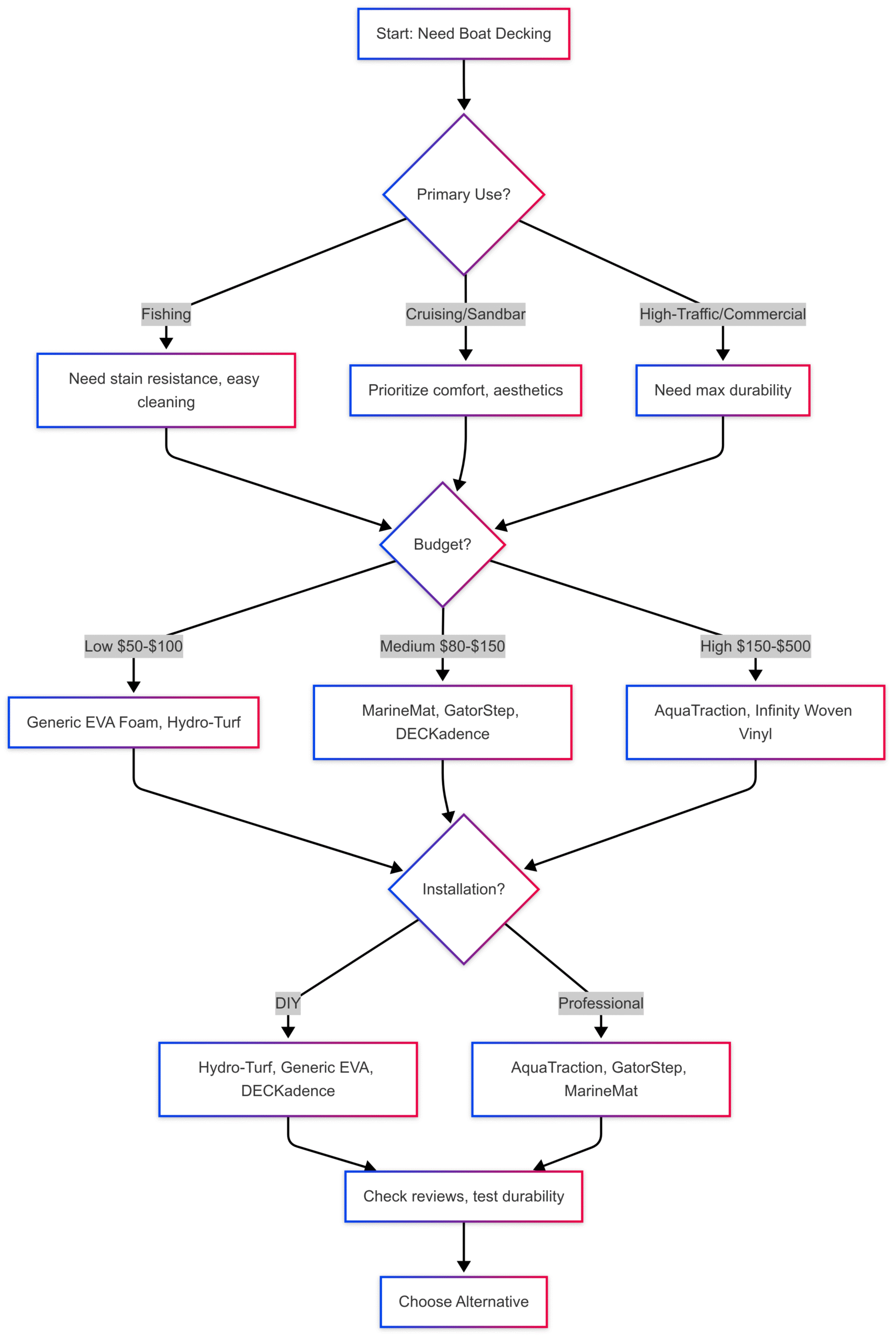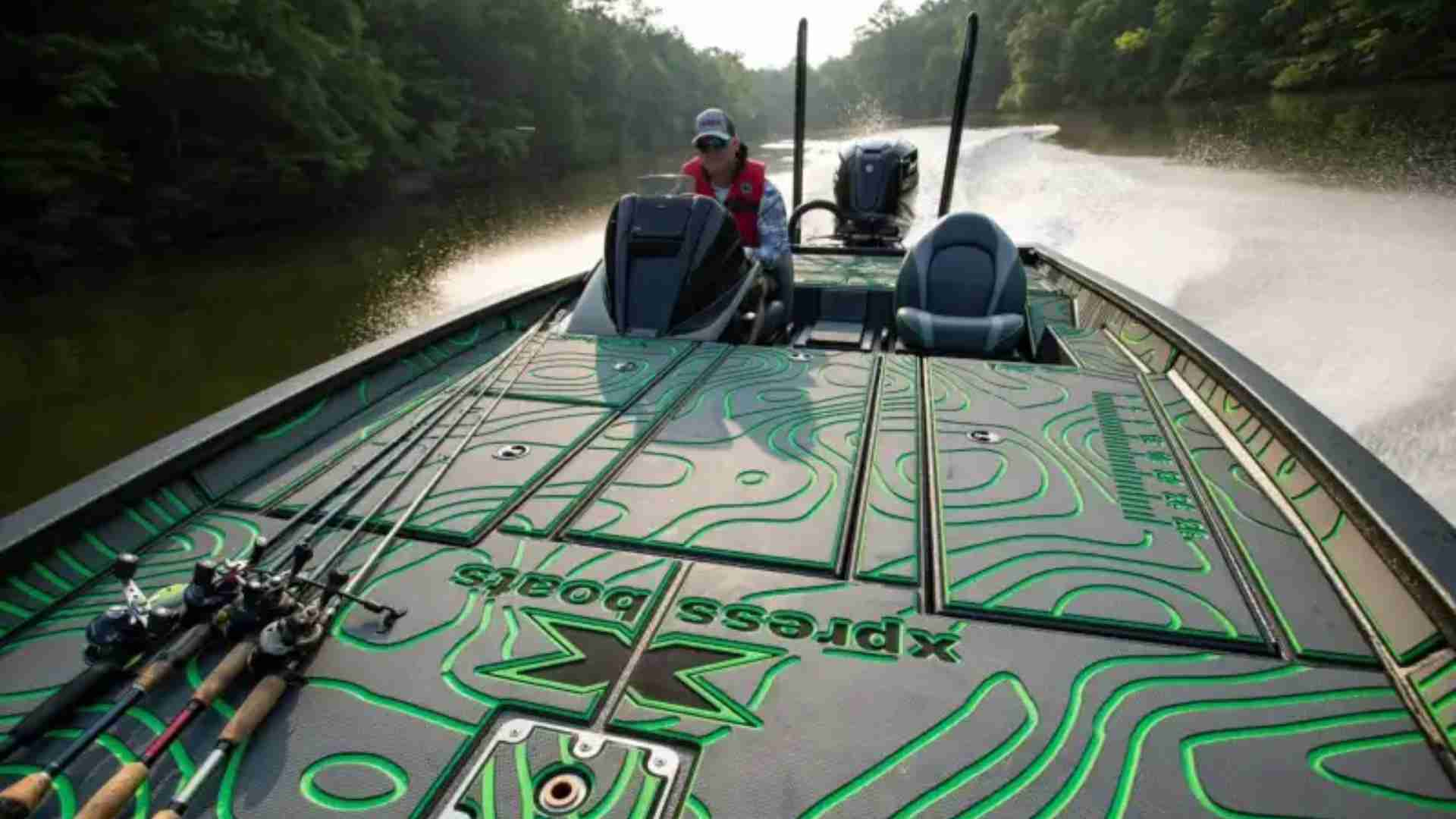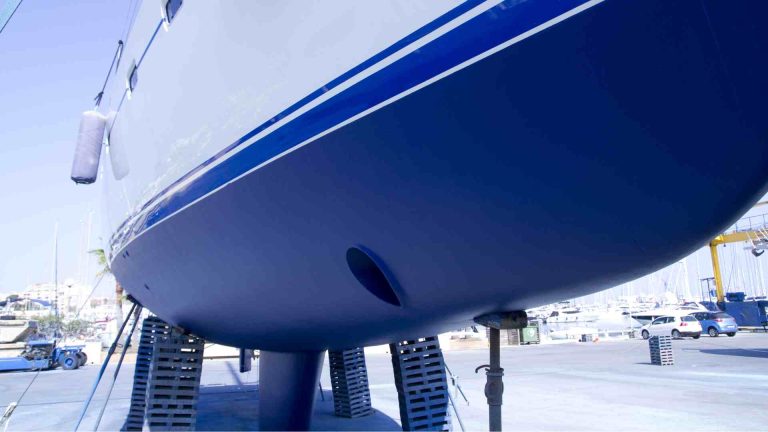Finding the Best Seadek Alternative for Your Boat
Discover the best SeaDek alternatives for your boat, comparing durability, cost, and installation. Find top options like Hydro-Turf, AquaTraction, and more.
Boat decking is a critical component for any vessel, enhancing safety, comfort, and aesthetics. SeaDek has long been a trusted name in marine flooring, known for its non-slip surface, durability, and customization options. However, its premium price, complex installation, and heat retention in sunny climates have led many boat owners to seek alternatives. This article explores the best SeaDek alternatives, including Hydro-Turf, AquaTraction, MarineMat, GatorStep, and budget-friendly EVA foam options, to help you choose the ideal decking for your boat. We’ll cover key factors to consider, compare top alternatives, and provide practical insights based on user experiences and industry feedback.
Why Boat Decking Matters
Boat decking is more than just a cosmetic upgrade—it’s a functional necessity. A quality decking material provides:
- Safety: Non-slip surfaces reduce the risk of falls, especially in wet or rough conditions, ensuring secure footing for passengers and crew.
- Comfort: Cushioned decking absorbs shock, reducing fatigue during long trips and providing a softer surface for bare feet.
- Aesthetics: Customizable colors, textures, and patterns enhance a boat’s visual appeal, reflecting the owner’s style.
- Durability: Marine-grade decking withstands harsh conditions like UV rays, saltwater, and heavy foot traffic, maintaining performance over time.
Poor decking choices can lead to safety hazards, discomfort, or frequent replacements, making it essential to select a material that balances these factors with your budget and boating needs.
What Makes SeaDek Stand Out?
SeaDek, a PE/EVA foam blend, is a premium marine flooring option favored for its:
- Non-Slip Traction: Exceptional grip, even when wet, ensures safety in dynamic marine environments.
- Comfort: Soft, cushioned surface reduces fatigue, ideal for long days on the water.
- Durability: UV-resistant and capable of withstanding heavy use, with a reported lifespan of 5-7 years under normal conditions.
- Customization: Wide range of colors, textures (e.g., brushed, embossed), and laser-etched designs for a personalized look.
- Ease of Cleaning: Resists stains and cleans easily with mild soap and water, though fish blood and heavy stains require prompt attention.
SeaDek Drawbacks
Despite its popularity, SeaDek has some limitations:
- Cost: Professional installation for a 23-foot boat can cost $2,500-$5,000, depending on the region and customization.
- Installation Complexity: Requires precise measurements and cutting, often necessitating professional help, which adds to the expense.
- Heat Retention: Can become hot under direct sunlight, especially in warmer climates like Florida.
- Maintenance: While durable, it may develop bubbles or edge lifting over time, especially if exposed to constant sun and saltwater.
Given these drawbacks, many boaters explore alternatives that offer similar benefits at a lower cost or with easier installation.
Key Factors to Consider When Choosing a SeaDek Alternative
Selecting the right decking involves evaluating several factors to ensure it meets your boat’s needs and your preferences. Here are the key considerations:
1. Material and Durability
The material composition affects longevity and performance:
- PE/EVA Blend vs. EVA vs. PE: SeaDek’s PE/EVA blend is known for durability, but pure EVA options (e.g., MarineMat) may be less resilient in harsh conditions. Pure PE materials, like AquaTraction, offer greater density and potentially better stain resistance.
- UV and Saltwater Resistance: Look for materials designed to withstand prolonged sun exposure and saltwater corrosion.
- Wear Resistance: High-traffic areas require robust materials that resist abrasion, delamination, or chalking.
2. Installation and Maintenance
- Ease of Installation: Pre-cut kits or peel-and-stick adhesives simplify DIY projects, while custom designs may require professional installation.
- Maintenance Needs: Choose materials that clean easily and resist mold, mildew, and stains. Some options, like DECKadence, are removable for thorough cleaning.
- Adhesive Quality: Strong adhesives, like 3M peel-and-stick, ensure long-term adhesion but may complicate removal.
3. Cost and Value
- Upfront Cost: SeaDek is pricier, with sheets costing $540 each for professional installs. Alternatives like Hydro-Turf ($70-$100/sheet) or generic EVA foam ($50-$100/sheet) are more budget-friendly.
- Long-Term Value: Consider durability, warranty, and maintenance costs. Cheaper options may need frequent replacement, negating initial savings.
- Warranty: Brands like OceanGrip offer warranties, but coverage varies. Check terms for delamination or fading.
4. Aesthetics and Customization
- Color and Texture Options: Most alternatives offer multiple colors and patterns, though some (e.g., MarineMat) have fewer customization options than SeaDek.
- Custom Designs: Brands like AquaTraction excel in fine logo work and intricate cuts, ideal for personalized aesthetics.
5. Specific Use Cases
- Fishing Boats: Need stain-resistant, durable surfaces that handle blood and fish guts. Hydro-Turf and AquaTraction are popular for their easy cleaning.
- Recreational Boats: Prioritize comfort and aesthetics for leisurely cruises or sandbar trips.
- High-Traffic Areas: Commercial or heavily used boats require rugged options like SeaDek HD or GatorStep.
6. Environmental Conditions
- Climate: In hot climates, materials that stay cool (e.g., AquaTraction, Infinity Woven Vinyl) are preferable.
- Storage: Boats stored outdoors need UV-resistant materials, while covered storage extends decking lifespan.
Top SeaDek Alternatives
Below, we explore the top SeaDek alternatives based on user feedback, durability, cost, and performance. Each option is evaluated for its strengths and weaknesses to help you make an informed choice.
1. Hydro-Turf
Hydro-Turf is a well-established brand offering foam-based marine decking, popular for its durability and affordability. It’s widely used in fishing and wake boats.
Features:
- Material: EVA foam with optional 3M peel-and-stick adhesive.
- Traction: Excellent grip, wet or dry, with diamond or lined tread patterns for water drainage.
- Durability: Resists UV rays and saltwater, with users reporting 5+ years of use without issues (e.g., coaming bolsters).
- Customization: Available in multiple colors and patterns, with custom cuts and logos possible.
- Cost: $70-$100/sheet (peel-and-stick), significantly cheaper than SeaDek.
Pros:
- Cleans easily with soap and water.
- Stays cool in direct sunlight and doesn’t freeze in cold weather.
- DIY-friendly with adhesive-backed sheets.
Cons:
- Limited customization compared to SeaDek or AquaTraction.
- Some users report peeling if not installed with additional adhesives (e.g., 3M spray adhesive, Weldwood contact cement).
User Feedback: A user with a GatorTrax duck boat praised Hydro-Turf for its durability, easy cleaning, and non-slip performance, even with wet dogs onboard. It’s a cost-effective choice for small projects or full deck installations.
2. AquaTraction
AquaTraction uses pure PE foam, offering superior density and stain resistance compared to EVA-based options. It’s gaining traction for its customization and performance.
Features:
- Material: 100% PE foam, less prone to expansion/contraction from temperature changes.
- Traction: Exceptional grip, even in swells, enhancing safety on center consoles.
- Durability: Highly UV-resistant and stain-resistant, with users reporting no issues after months of use.
- Customization: Excels in fine logo work and intricate laser etching for custom designs.
- Cost: Comparable to SeaDek ($100-$150/sheet), but competitive for custom work.
Pros:
- Doesn’t retain heat, ideal for sunny climates.
- Easy to clean, resists stains from blood or dirt.
- Excellent customer service and communication.
Cons:
- Limited long-term feedback (less than 5 years) compared to SeaDek.
- Slightly higher cost than budget options.
User Feedback: A Key West boater (coores14) reported satisfaction with AquaTraction cooler pads, noting minimal staining and good company support. Another user on a 20’ center console highlighted its transformative grip and comfort.
3. MarineMat
MarineMat offers cushioned, slip-resistant EVA foam decking, available in adhesive or snap-in formats, making it versatile for various boats.
Features:
- Material: EVA foam with optional snap-in or adhesive backing.
- Traction: Reliable non-slip surface, suitable for wet conditions.
- Durability: UV-resistant, but some users report shrinking or peeling in Florida’s intense sun after 1-2 years.
- Customization: Fewer color and design options than SeaDek or AquaTraction.
- Cost: $80-$120/sheet, slightly more affordable than SeaDek.
Pros:
- Snap-in option allows easy removal for cleaning.
- Comfortable underfoot, ideal for cruising boats.
- DIY-friendly for smaller projects.
Cons:
- Durability issues in high-UV environments (e.g., Florida).
- Limited customization compared to competitors.
User Feedback: A Florida boater (NitroSun) reported MarineMat peeling and shrinking within a year, while others praised its initial look and comfort. The snap-in series is popular for boats with existing carpet snaps.
4. GatorStep
GatorStep is known for its large panel sizes, reducing seams for a cleaner look, and its focus on durability and performance.
Features:
- Material: EVA foam with strong adhesive backing.
- Traction: Excellent grip, comparable to SeaDek.
- Durability: Designed for heavy use, with positive feedback on longevity.
- Customization: Wide range of textures and colors, with custom cuts available.
- Cost: $100-$150/sheet, competitive with AquaTraction.
Pros:
- Larger panels create a seamless appearance.
- Strong customer service, with direct owner support.
- Durable in high-traffic areas.
Cons:
- Installation can be challenging for large panels without professional help.
- Limited long-term user reviews compared to SeaDek.
User Feedback: A boater (apalehorse) praised GatorStep’s seamless look and excellent customer service, though installation of large panels was noted as difficult.
5. Generic EVA Foam (Amazon/eBay)
Budget-friendly EVA foam sheets from online retailers like Amazon or eBay are popular for DIY projects but vary widely in quality.
Features:
- Material: EVA foam, often with 3M adhesive backing.
- Traction: Decent grip but may wear down faster than premium brands.
- Durability: Highly variable; some sheets last 1-2 years, while others degrade within months.
- Customization: Limited to basic colors and patterns; hand-cutting required for custom fits.
- Cost: $50-$100/sheet, the cheapest option.
Pros:
- Extremely affordable, ideal for small projects or low-budget boats.
- Easy to install for simple applications (e.g., cooler pads).
- Readily available online.
Cons:
- Inconsistent quality, with issues like chalking, fading, or delamination.
- Not suitable for high-traffic or exposed areas.
- Hand-cutting leads to less polished results.
User Feedback: Users like Rico2 found installation straightforward but noted availability issues. Others (e.g., pwrhd) reported rapid degradation in sunny conditions, with material washing away as dust.
6. DECKadence
DECKadence offers a removable, non-adhesive marine flooring solution, ideal for boats needing easy cleaning or temporary decking.
Features:
- Material: Thick EVA foam, designed for water drainage.
- Traction: Good grip, with a focus on cushioning.
- Durability: UV-resistant, but less tested in extreme conditions.
- Customization: Custom logos available, but limited color options.
- Cost: $80-$120/sheet, comparable to MarineMat.
Pros:
- Removable for easy cleaning, no adhesive residue.
- Comfortable and cool underfoot.
- Suitable for wake boats or areas with dive tanks.
Cons:
- Not ideal for hardcore fishing boats due to thickness.
- Limited feedback on long-term durability.
User Feedback: A boater (billablehours) praised DECKadence for its cushioning and ease of installation without adhesives, planning to share further reviews post-installation.
7. Infinity Woven Vinyl
Infinity Woven Vinyl is a vinyl-based alternative, not foam, offering a different aesthetic and performance profile.
Features:
- Material: Woven vinyl, durable and stain-resistant.
- Traction: Good grip, though less cushioned than foam options.
- Durability: Highly resistant to stains, UV rays, and fish blood.
- Customization: Multiple colors and patterns, available in snap-in or adhesive formats.
- Cost: Approximately 50% less than SeaDek ($250-$500 for a small boat).
Pros:
- Easy to clean, ideal for fishing boats with heavy mess.
- Doesn’t retain heat, suitable for sunny climates.
- Long-lasting in harsh conditions.
Cons:
- Less cushioned than foam-based options.
- Different aesthetic, resembling vinyl carpet rather than foam.
User Feedback: A center console owner (Jacādie’s friend) swore by Infinity Woven Vinyl for its stain resistance and easy cleaning, especially for offshore fishing.
Comparison Table of SeaDek Alternatives
| Brand | Material | Cost/Sheet | Durability | Traction | Customization | Installation | Best For |
|---|---|---|---|---|---|---|---|
| SeaDek | PE/EVA Blend | $540 | 5-7 years | Excellent | High | Professional | Premium, custom boats |
| Hydro-Turf | EVA Foam | $70-$100 | 5+ years | Excellent | Moderate | DIY/Professional | Fishing, wake boats |
| AquaTraction | PE Foam | $100-$150 | 3-5 years | Excellent | High | Professional | Custom designs, sunny climates |
| MarineMat | EVA Foam | $80-$120 | 1-3 years | Good | Moderate | DIY/Snap-in | Cruising, removable needs |
| GatorStep | EVA Foam | $100-$150 | 3-5 years | Excellent | High | Professional | Seamless look, high-traffic |
| Generic EVA (Amazon) | EVA Foam | $50-$100 | 1-2 years | Moderate | Low | DIY | Budget, small projects |
| DECKadence | EVA Foam | $80-$120 | 2-4 years | Good | Moderate | Removable | Wake boats, easy cleaning |
| Infinity Woven Vinyl | Woven Vinyl | $250-$500/boat | 5+ years | Good | Moderate | Snap-in/Adhesive | Fishing, stain resistance |
Chart: Decision-Making Flow for Choosing a SeaDek Alternative

This chart guides boaters through the decision-making process, starting with the boat’s primary use, budget, and installation preferences, leading to the most suitable SeaDek alternative.
User Insights and Real-World Experiences
User feedback from boating forums highlights the strengths and weaknesses of these alternatives:
- SeaDek Longevity: A South Florida boater (MjRabs) reported SeaDek lasting 7.5 years on a bay boat, with minor bubbling and grit after heavy sun exposure. The snow-camo pattern masked fading, and fish blood cleaned easily.
- OceanGrip Issues: Coores14 experienced delamination and chalking with OceanGrip within 6-8 months, despite warranty replacement, suggesting inconsistent quality.
- AquaTraction Satisfaction: Users like coores14 and tcastric praised AquaTraction for its grip, stain resistance, and customer service, with no significant issues after months of use.
- Generic EVA Challenges: Multiple users (e.g., pwrhd, Pierpressure1) reported rapid degradation of Amazon/eBay EVA foam, with fading and material loss within 1-2 years in sunny conditions.
- Hydro-Turf Reliability: SalmonDaze noted 5 years of issue-free use for coaming bolsters, emphasizing Hydro-Turf’s durability and value.
Tips for Choosing and Installing Your Decking
- Research Thoroughly: Read customer reviews on forums like The Hull Truth or Club Sea Ray to gauge real-world performance. Compare warranty terms and user experiences in similar climates.
- Test Samples: Request material samples to assess texture, grip, and heat retention before committing.
- Professional vs. DIY Installation:
- DIY: Suitable for Hydro-Turf, Generic EVA, or DECKadence. Use additional adhesives (e.g., 3M spray, Weldwood contact cement) for edges to prevent peeling.
- Professional: Recommended for AquaTraction, GatorStep, or complex SeaDek installs to ensure precision.
- Surface Preparation: Clean and sand the deck to ensure strong adhesion. Remove old adhesive with xylene or mineral spirits if replacing existing decking.
- Maintenance: Rinse regularly with fresh water and mild soap to prevent staining. Avoid abrasive cleaners or high-pressure streams that could damage foam.
- Consider Removable Options: MarineMat’s snap-in series or DECKadence are ideal for boats needing frequent deep cleaning.
Removing Existing Decking
If replacing SeaDek or another material, removal can be labor-intensive:
- Process: Peel off the material, then use xylene and a stiff brush (or drill brush) to remove adhesive residue. Expect 4-8 hours for a full deck.
- Challenges: Residual adhesive may require solvents like mineral spirits or GooGone. Ensure the surface is clean before applying new decking.
- Non-Slip Gelcoat: Some boats have non-slip gelcoat beneath; if not, consider applying a durable coating like KiwiGrip for a permanent solution.
Making the Final Decision
To choose the best SeaDek alternative:
- Assess Your Needs: Determine your boat’s primary use (fishing, cruising, commercial) and environmental conditions (sun exposure, saltwater).
- Balance Cost and Quality: Budget options like Generic EVA are tempting but may not last. Mid-range options like Hydro-Turf or MarineMat offer a good compromise.
- Prioritize Key Features: If customization is key, opt for AquaTraction or GatorStep. For fishing boats, Infinity Woven Vinyl or Hydro-Turf excel in stain resistance.
- Check Long-Term Value: Review durability, maintenance, and warranty. AquaTraction and Hydro-Turf often outperform cheaper alternatives in harsh conditions.
- Get Quotes: Shop around, as installer prices vary significantly (e.g., $1,000 difference for MarineMat noted by Jacādie).
Conclusion
Choosing the best SeaDek alternative depends on balancing safety, comfort, durability, aesthetics, and budget. Hydro-Turf offers affordability and reliability for fishing and wake boats, while AquaTraction excels in customization and stain resistance. MarineMat and DECKadence provide flexibility with snap-in or removable options, and GatorStep delivers a seamless look for high-traffic areas. Budget-conscious boaters may consider Generic EVA foam for small projects, but longevity is a concern. Infinity Woven Vinyl stands out for fishing boats needing easy cleaning and heat resistance.
By evaluating your boat’s specific needs, researching user experiences, and comparing features, you can select a decking material that enhances your boating experience without breaking the bank. Whether you prioritize durability, ease of installation, or a custom aesthetic, there’s a SeaDek alternative that’s perfect for your vessel.
Happy Boating!
Share Finding the Best Seadek Alternative for Your Boat with your friends and leave a comment below with your thoughts.
Read Guide to Understanding Your Marine Oil Pressure Gauge until we meet in the next article.






